






Testing the waters
Some of the city's most outspoken critics take a first-hand look at
the city's ocean water monitoring program ... and come away impressed.
by Lori Saldaña
 he fog was just burning off over the Pacific Ocean as
representatives from the Sierra Club, Surfrider Foundation, Audubon Society
and San Diego Council of Divers arrived at the city of San Diego's Environmental
Monitoring office near Shelter Island. Our group represented the San Diego
Clean Water Alliance, an association created earlier this year to support
Clean Water Act protection for San Diego via lobbying, petitioning, public
meetings and community activism.
he fog was just burning off over the Pacific Ocean as
representatives from the Sierra Club, Surfrider Foundation, Audubon Society
and San Diego Council of Divers arrived at the city of San Diego's Environmental
Monitoring office near Shelter Island. Our group represented the San Diego
Clean Water Alliance, an association created earlier this year to support
Clean Water Act protection for San Diego via lobbying, petitioning, public
meetings and community activism.
 Members of the Alliance had been invited to take a short
trip on the Monitor III, the largest of the city's three water quality monitoring
boats. The city wanted to reassure us that, despite Congressional efforts
to exempt Pt. Loma from the Clean Water Act, their monitoring program was
keeping a close eye on ocean water quality.
Members of the Alliance had been invited to take a short
trip on the Monitor III, the largest of the city's three water quality monitoring
boats. The city wanted to reassure us that, despite Congressional efforts
to exempt Pt. Loma from the Clean Water Act, their monitoring program was
keeping a close eye on ocean water quality.
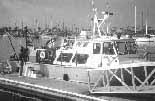
 The Monitor III, largest of the
city's three ocean water monitoring boats. Starting this year, the boats
are out almost every day.
The Monitor III, largest of the
city's three ocean water monitoring boats. Starting this year, the boats
are out almost every day.
Get with the program
Funded by the city, the ocean water quality monitoring program is intended
to measure the general biological health of the area from the U.S./Mexico
border to Del Mar. The program has been described by some as the largest
in the world, with an estimated 250,000 samples gathered and analyzed each
year. In 1985, there were only 60 to 80 days of sampling per year. But starting
this year, the boats and crews are expected to be out nearly every day.
 The city's three boats carry technicians, chemists and
biologists out to 38 testing stations, covering an 85 square mile area.
Tim Rothans, a marine biologist and Ocean Operations Supervisor for the
city's boats, explained that on a typical day the boats are out sampling
for eight hours (today's trip would only last two to three hours). The stations
in the kelp beds closest to shore are sampled every eight days.
The city's three boats carry technicians, chemists and
biologists out to 38 testing stations, covering an 85 square mile area.
Tim Rothans, a marine biologist and Ocean Operations Supervisor for the
city's boats, explained that on a typical day the boats are out sampling
for eight hours (today's trip would only last two to three hours). The stations
in the kelp beds closest to shore are sampled every eight days.
 Alan Langworthy, Deputy Director of the Metropolitan
Wastewater Department's Environmental Monitoring and Technical Services
Division, showed us charts of the monitored areas. He stressed the recent
addition of the border area near Tijuana to the monitor sites. With construction
of the ocean outfall for the International Wastewater Treatment Plant scheduled
to begin in April 1996, these new samples provide baseline measurements
of pre-construction conditions. After operation of the outfall begins, deviation
from the earlier measurements can be attributed to the plant operation.
Alan Langworthy, Deputy Director of the Metropolitan
Wastewater Department's Environmental Monitoring and Technical Services
Division, showed us charts of the monitored areas. He stressed the recent
addition of the border area near Tijuana to the monitor sites. With construction
of the ocean outfall for the International Wastewater Treatment Plant scheduled
to begin in April 1996, these new samples provide baseline measurements
of pre-construction conditions. After operation of the outfall begins, deviation
from the earlier measurements can be attributed to the plant operation.
 According to Langworthy, "This is a traditional
compliance-based sampling method, focused on the Pt. Loma discharge."
But he was quick to point out that factors other than the outfall, including
frequent land-based sewage spills and storm drain run-off, complicate analysis.
Rothans reminded the group that this team is responsible for monitoring
only from the shore out. Resources for tracking and repairing land-based
problems have not been given the same priority as the ocean monitoring program.
According to Langworthy, "This is a traditional
compliance-based sampling method, focused on the Pt. Loma discharge."
But he was quick to point out that factors other than the outfall, including
frequent land-based sewage spills and storm drain run-off, complicate analysis.
Rothans reminded the group that this team is responsible for monitoring
only from the shore out. Resources for tracking and repairing land-based
problems have not been given the same priority as the ocean monitoring program.
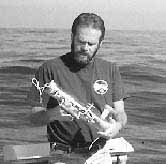


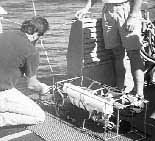
Left: Marine biologist Mike Kelly holds a Van Dorn sampler,
used to bring up water samples for chemical analysis. Right: Mike
prepares to launch a CTD, an electronic device that records a profile of
water conductivity, temperature and depth. The data will later be loaded
directly into a shipboard computer.
Out to sea
Once briefed on the logistics of the sampling, our group finally got underway.
Even before leaving San Diego Bay we could see and hear wildlife all around
us. Harbor seals lounged on the navigational buoys in the harbor, hardly
noticing as our two noisy diesel engines approached. Gulls, cormorants and
terns flew and dove nearby, perhaps hoping we were a sportfishing boat with
a few spare anchovies on board. It was a beautiful day to be on the water.
 Our group crammed into the small lower cabin of the
Monitor III to learn more about the lab and testing equipment on-board the
42-foot craft. At first, we all listened to a description of the various
collection tools, bottles and techniques used during the chemistry analysis.
But once past Pt. Loma, large swells rolling in from the north - pitching
the boat from side to side - drove us above decks to the fresh air.
Our group crammed into the small lower cabin of the
Monitor III to learn more about the lab and testing equipment on-board the
42-foot craft. At first, we all listened to a description of the various
collection tools, bottles and techniques used during the chemistry analysis.
But once past Pt. Loma, large swells rolling in from the north - pitching
the boat from side to side - drove us above decks to the fresh air.
 On the bridge, Jack Russell, captain of the Monitor
III, demonstrated the latest technology used to navigate the city's largest
monitoring boat. A global positioning system (GPS) with 120 pre-programmed
stations can pinpoint the boat's location to within a few feet. A brightly
colored sonar display is used for identifying underwater structures. As
we approached the outfall, only 100 feet below the surface, Russell pointed
to the underwater sonar image on one screen, and the corresponding "blip"
on the GPS screen, confirming the boat's surface location directly over
the outfall.
On the bridge, Jack Russell, captain of the Monitor
III, demonstrated the latest technology used to navigate the city's largest
monitoring boat. A global positioning system (GPS) with 120 pre-programmed
stations can pinpoint the boat's location to within a few feet. A brightly
colored sonar display is used for identifying underwater structures. As
we approached the outfall, only 100 feet below the surface, Russell pointed
to the underwater sonar image on one screen, and the corresponding "blip"
on the GPS screen, confirming the boat's surface location directly over
the outfall.
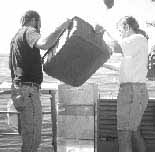


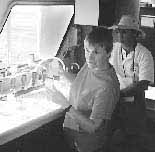
Left: Staff members filter bottom sediments to separate the tiny worms,
crabs and other bottom dwellers. A thriving population is taken as a sign
of a healthy environment. Right: Marine microbiologist Mary Ellen
Kruse analyzes water samples in this shipboard laboratory. Tests look for
healy metals, pesticides and other potential toxins.
Testing, testing ...
We had arrived at one of the pre-determined research stations, and Tim Rothans
and marine biologist Mike Kelly got to work. "Work" consisted
of dropping sampling devices like the "CTD" (records water Conductivity,
Temperature and Depth), the Van Veen sampler (grabs bottom sediment) and
the Van Dorn bottle (takes water samples) over the side.
 Once the devices reached thir required depth, they were
hauled up and given to Mary Ellen Kruse, a marine microbiology supervisor
from the Alvarado Water Filtration Biology Lab, for analysis. The CTD contains
a recorder that transfers its measurements directly to a shipboard computer.
Water samples from the Van Dorn are subjected to chemical analysis that
measures toxins like pesticides and heavy metals, and biological oxygen
demand, an indication of microbial action.
Once the devices reached thir required depth, they were
hauled up and given to Mary Ellen Kruse, a marine microbiology supervisor
from the Alvarado Water Filtration Biology Lab, for analysis. The CTD contains
a recorder that transfers its measurements directly to a shipboard computer.
Water samples from the Van Dorn are subjected to chemical analysis that
measures toxins like pesticides and heavy metals, and biological oxygen
demand, an indication of microbial action.
 Bottom sediment from the Van Veen sampler was hauled
on board complete with a collection of tiny worms, crabs and other benthic
invertebrates that were almost too small to see. These make up the so-called
"indigenous population" around the outfall, tiny creatures that
make their home by burrowing into the top layers of sediment and feeding
on ocean detritus. Biologists take repeated samples of these creatures from
around the outfall, and assume that their survival and health indicates
the effluent from the outfall is not harming the ocean environment.
Bottom sediment from the Van Veen sampler was hauled
on board complete with a collection of tiny worms, crabs and other benthic
invertebrates that were almost too small to see. These make up the so-called
"indigenous population" around the outfall, tiny creatures that
make their home by burrowing into the top layers of sediment and feeding
on ocean detritus. Biologists take repeated samples of these creatures from
around the outfall, and assume that their survival and health indicates
the effluent from the outfall is not harming the ocean environment.
 The data gathered is presented in a monthly report to
the Regional Water Control Board; in addition, the group produces an annual
report of ocean water quality. This information is available to citizens
from the Clean Water Libary in downtown San Diego.
The data gathered is presented in a monthly report to
the Regional Water Control Board; in addition, the group produces an annual
report of ocean water quality. This information is available to citizens
from the Clean Water Libary in downtown San Diego.
 It was late morning by then, and the wind and swells
were picking up. As the Monitor III headed back to Shelter Island, Alliance
members spoke with the biologists and chemists, impressed by their commitment
to keep a close watch on the ocean's health, even if that meant going to
sea 364 days a year.
It was late morning by then, and the wind and swells
were picking up. As the Monitor III headed back to Shelter Island, Alliance
members spoke with the biologists and chemists, impressed by their commitment
to keep a close watch on the ocean's health, even if that meant going to
sea 364 days a year.
 I think that it safe to say that our group was probably
the most sceptical that the city has ever hosted on such a tour. Yet afterwards,
we all felt reassured that San Diego's ocean water testing program is in
capable hands. Unfortunately, when it comes to the policy makers in city
hall and Washington DC ... well, that's a whole other story.
I think that it safe to say that our group was probably
the most sceptical that the city has ever hosted on such a tour. Yet afterwards,
we all felt reassured that San Diego's ocean water testing program is in
capable hands. Unfortunately, when it comes to the policy makers in city
hall and Washington DC ... well, that's a whole other story.

Lori Saldaña, a regular contributor to the Earth Times, is
a writer, public speaker and photographer who specializes in conservation
and environmental issues, and an environmental activist.










